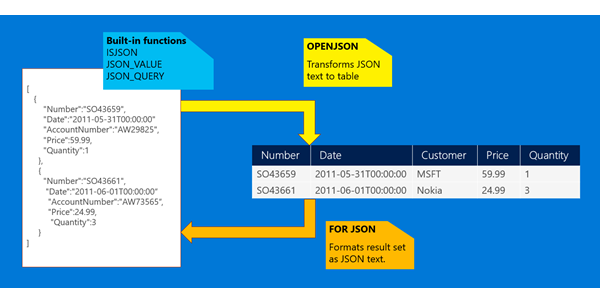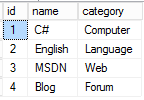JSON是一個非常流行的,用於數據交換的數據格式,主要用於Web和移動應用程式中。JSON 使用鍵/值對(Key:Value pair)存儲數據,並且表示嵌套鍵值對和數組兩種複雜數據類型,僅僅使用逗號(引用Key)和中括弧(引用數組元素),就能路由到指定的屬性或成員,使用簡單,功能強大。在SQL S ...
JSON是一個非常流行的,用於數據交換的文本數據(textual data)格式,主要用於Web和移動應用程式中。JSON 使用“鍵/值對”(Key:Value pair)存儲數據,能夠表示嵌套鍵值對和數組兩種複雜數據類型,JSON僅僅使用逗號(引用Key)和中括弧(引用數組元素),就能路由到指定的屬性或成員,使用簡單,功能強大。在SQL Server 2016版本中支持JSON格式,使用Unicode字元類型表示JSON數據,並能對JSON數據進行驗證,查詢和修改。推薦一款JSON驗證和格式化的線上工具:json formatter。
SQL Server 提供了內置函數,用於查詢和更新JSON數據,分析JSON文本,如圖:

一,定義和驗證JSON數據
使用nvarchar存儲JSON文本數據,通過函數 ISJSON(expression) 驗證JSON數據是否有效。
declare @json nvarchar(max) set @json = N'{ "info":{ "type":1, "address":{ "town":"bristol", "county":"avon", "country":"england" }, "tags":["sport", "water polo"] }, "type":"basic" }' select isjson(@json)
ISJSON 函數的格式是: ISJSON ( expression ) ,返回1,表示字元串是JSON數據;返回0,表示字元串不是JSON數據;返回NULL,表示 expression是NULL;
二,JSON 數據的PATH 表達式
Path 表達式分為兩部分:Path Mode和Path,Path Mode是可選的(optional),有兩種模式:lax和strict。
1,Path Mode
在Path 表達式的開始,可以通過lax 或 strict 關鍵字顯式聲明Path Mode,如果不聲明,預設的Path Mode是lax。在lax 模式下,如果path表達式出錯,那麼JSON函數返回NULL。在strict模式下,如果Path表達式出錯,那麼JSON函數拋出錯誤;
2,Path 表達式
Path是訪問JSON數據的途徑,有四種運算符:
- $:代表整個JSON 數據的內容;
- 逗號 . :表示JSON對象的成員,也叫做,欄位(Field),或Key;
- 中括弧 [] :表示數組中的元素,元素的起始位置是0;
- Key Name:鍵的名字,通過Key Name引用對應的Value;如果Key Name中包含空格,$,逗號,中括弧,使用雙引號;
例如,有如下JSON 數據,通過Path表達式,能夠路由到JSON的各個屬性:
{ "people": [ { "name": "John", "surname": "Doe" }, { "name": "Jane", "surname": null, "active": true } ] }
Path表達式查詢的數據是:
- $:表示JSON的內容,是最外層大括弧中的所有Item,本例是一個people數組,數組的下標是從0開始的;
- $.people[0]:表示people數組的第一元素:{ "name": "Jane", "surname": null, "active": true }
- $.people[0].name :從people數組的第一個元素中,查詢Key是Name的Item對應的數據,本例是John;
- $.people[1].surname:people數組中部存在surname 欄位,由於該Path 表達式沒有聲明Path Mode,預設值是lax,當Path表達式出現錯誤時,返回NULL;
三,通過Path查詢JSON數據
1,查詢標量值(JSON_VALUE)
使用 JSON_VALUE(expression , path ) 函數,從JSON數據,根據Path 參數返回標量值,返回的數據是字元類型。
declare @json nvarchar(max) set @json = N'{ "info":{ "type":1, "address":{ "town":"bristol", "county":"avon", "country":"england" }, "tags":["sport", "water polo"] }, "type":"basic" }' select json_value(@json, '$.type') as type, json_value(@json, '$.info.type') as info_type, json_value(@json, '$.info.address.town') as town, json_value(@json, '$.info.tags[0]') as tag

2,返回JSON數據(JSON_QUERY)
使用 JSON_QUERY ( expression [ , path ] ) 函數,根據Path 參數,返回JSON 數據(JSON fragment);參數path是可選的(optional),如果不指定option參數,那麼預設的path是$,即,返回整個JSON數據。
declare @json nvarchar(max) set @json = N'{ "info":{ "type":1, "address":{ "town":"bristol", "county":"avon", "country":"england" }, "tags":["sport", "water polo"] }, "type":"basic" }' select json_query(@json, '$') as json_context, json_query(@json, '$.info') as info, json_query(@json, '$.info.address') as info_address, json_query(@json, '$.info.tags') as info_tags

四,通過Path修改JSON數據
使用 JSON_MODIFY ( expression , path , newValue ) 修改JSON數據中的屬性值,並返回修改之後的JSON數據,該函數修改JSON數據的流程是:
- 修改現有的屬性:按照參數path從JSON數據中找到指定的屬性,將該屬性的Value修改為參數newValue,返回值是修改之後的JSON數據;
- 新增新的鍵值對(Key:Value pair):如果JSON數據中不存在指定的屬性,那麼按照參數Path,在指定的路徑上新增鍵值對;
- 刪除鍵值對(Key:Value pair):如果參數newValue的值是NULL,那麼表示從JSON數據中刪除指定的屬性;
- append 關鍵字:用於從JSON數組中,追加一個元素;
示例,對JSON數據進行update,insert,delete和追加數據元素
declare @info nvarchar(100) = '{"name":"john","skills":["c#","sql"]}' -- update name set @info = json_modify(@info, '$.name', 'mike') -- insert surname set @info = json_modify(@info, '$.surname', 'smith') -- delete name set @info = json_modify(@info, '$.name', null) -- add skill set @info = json_modify(@info, 'append $.skills', 'azure')

五,將JSON數據轉換為關係表
OPENJSON函數是一個行集函數(RowSet),能夠將JSON數據轉換為關係表,

OPENJSON( jsonExpression [ , path ] ) [ WITH ( colName type [ column_path ] [ AS JSON ] [ , colName type [ column_path ] [ AS JSON ] ] [ , . . . n ] ) ]View Code
- path 參數:也叫table path,指定關係表在JSON數據中的路徑;
- column_path 參數:基於path參數,指定每個column在關係表JSON中的路徑,應總是顯式指定column path;
- AS JSON 屬性:如果指定AS JSON屬性,那麼 column的數據類型必須定義為nvarchar(max),表示該column的值是JSON數據;如果不指定AS JSON屬性,那麼該Column的值是標量值;
- with 選項:指定關係表的Schema,應總是指定with選項;如果不指定with 選項,那麼函數返回key,value和type三列;
示例,從JSON數據中,以關係表方式呈現數據
declare @json nvarchar(max) set @json = N'{ "info":{ "type":1, "address":{ "town":"bristol", "county":"avon", "country":"england" }, "tags":["sport", "water polo"] }, "type":"basic" }' SELECT info_type,info_address,tags FROM OPENJSON(@json, '$.info') with ( info_type tinyint 'lax $.type', info_address nvarchar(max) 'lax $.address' as json, tags nvarchar(max) 'lax $.tags' as json )
六,將關係表數據以JSON格式存儲
通過For JSON Auto/Path,將關係表數據存儲為JSON格式,
- Auto 模式:根據select語句中column的順序,自動生成JSON數據的格式;
- Path 模式:使用column name的格式來生成JSON數據的格式,column name使用逗號分隔(dot-separated)表示組-成員關係;
示例,有表:dt_json,存儲以下數據:

1,以Auto 模式生成JSON格式
select id, name, category from dbo.dt_json for json auto,root('json')
返回的數據格式是

{ "json":[ { "id":1, "name":"C#", "category":"Computer" }, { "id":2, "name":"English", "category":"Language" }, { "id":3, "name":"MSDN", "category":"Web" }, { "id":4, "name":"Blog", "category":"Forum" } ] }View Code
2,以Path模式生成JSON格式
select id as 'book.id', name as 'book.name', category as 'product.category' from dbo.dt_json for json path,root('json')
返回的數據格式是:

{ "json":[ { "book":{ "id":1, "name":"C#" }, "product":{ "category":"Computer" } }, { "book":{ "id":2, "name":"English" }, "product":{ "category":"Language" } }, { "book":{ "id":3, "name":"MSDN" }, "product":{ "category":"Web" } }, { "book":{ "id":4, "name":"Blog" }, "product":{ "category":"Forum" } } ] }View Code
七,索引JSON數據
JSON文本不是內置的數據類型,沒有專門的JSON索引,但是,可以通過創建計算列和標準B-Tree索引提高查詢JSON數據的性能,避免全表掃描(Full Table Scan),通過索引計算列,間接實現對JSON進行查找。
索引JSON數據的Workaround是:為查詢條件(Filter)創建計算列,使用persisted屬性持久存儲;在計算列上創建索引,使用包含列(Include)包含特定的欄位,以避免鍵值查找(Key Lookup),提高索引查找的性能。
例如,有如下關係表,欄位category包含JSON數據:

按照type屬性過濾,包含name欄位,創建索引的示例是:
alter table dbo.dt_json add category_type as (cast(json_value(category,'$.type') as int)) persisted; create nonclustered index idx_dt_json_category_type on dbo.dt_json ( category_type ) include(name);
參考文檔:
JSON Path Expressions (SQL Server)
Format Query Results as JSON with FOR JSON (SQL Server)
Format Nested JSON Output with PATH Mode (SQL Server)
Format JSON Output Automatically with AUTO Mode (SQL Server)
JSON Support in SQL Server 2016
JSON in SQL Server 2016: Part 1 of 4




